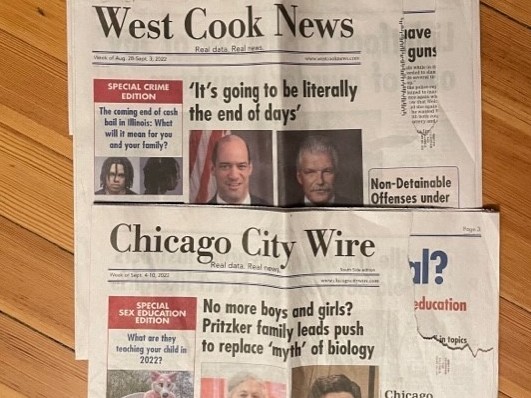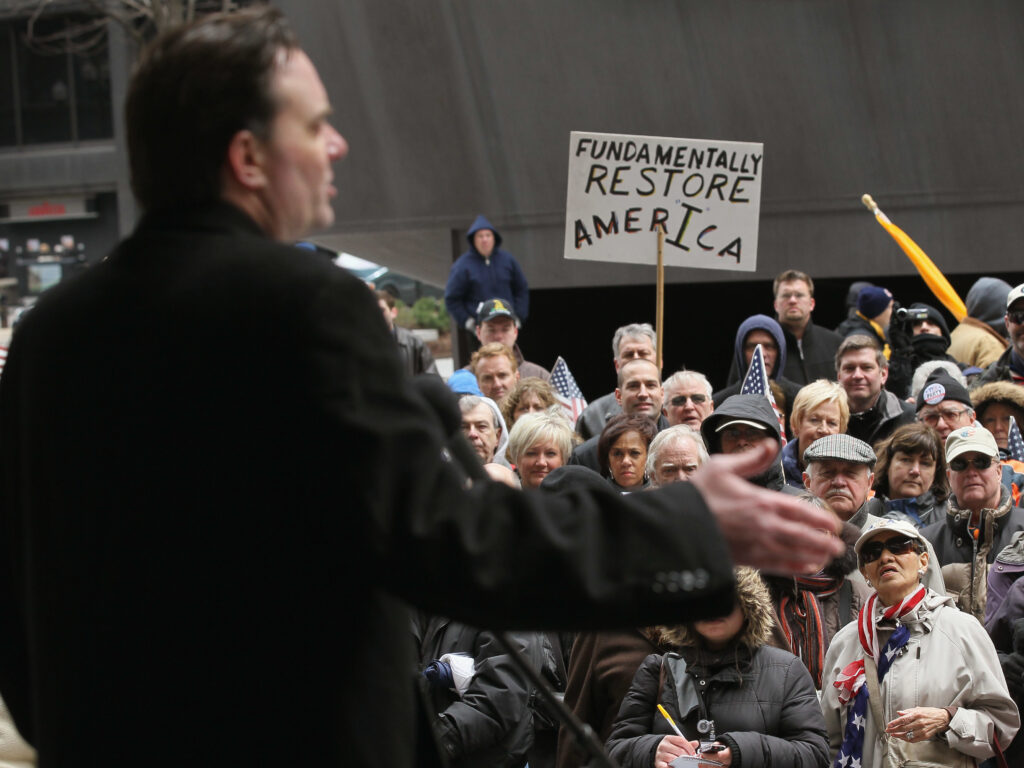SPRINGFIELD — Since late summer, many Illinois residents have been receiving newspapers that they haven’t paid for nor, in many cases, even heard of.
Each paper bears a clear-cut tagline: Real data, real news.
And each publication that shows up in driveways and mailboxes carries a partisan punch that’s blatant, but not formally disclosed.
“They present a strongly one-sided view of things,” said Bernard Schoenburg, who covered Illinois as a journalist for decades.
Schoenburg retired as a columnist for The State Journal-Register in Springfield in December 2020, 44 years after walking into his first job out of college at the Bloomington Pantagraph. In the intervening decades, traditional newsrooms throughout the state have withered, from the Pantagraph right up to the once-mighty Chicago Tribune. Some have shut down.
That erosion of local news has created an opening for these newer publications, which lie dormant and then spring up at election time. They look a lot like hometown newspapers — nothing flashy, just long, printed broadsheet pages with color photos and graphics — but without any real interest in local news.
“You get these glaring headlines of … what’s so terrible about our tax system right now or what’s bad about a Democratic governor,” Schoenburg said.
All signs point in one direction
The coverage all points in a single political direction: hard right.
Schoenburg first noticed these papers several election cycles ago, born out of the conservative Illinois Policy Institute, which crusaded against greater taxation and regulation. Since then, they have spread across the state, presenting themselves as down-home newspapers in multiple communities with names that hark back to times before people relied on social media to find out out about developments in their communities.
“In this age, with so many kinds of media that hit people,” Schoenburg said, “people don’t know, necessarily, what’s real, if they’re not sophisticated in this way.”
This fall, readers encountering the Sangamon Sun or Chicago City Wire or the Dupage Policy Journal or their sister publications will find coverage uniformly beating up on the policies and persona of Illinois Gov. J.B. Pritzker, a Democrat who happens to be up for reelection.
The West Cook News splashed an incendiary quote across the top of its front page recently: “It’s going to be literally the end of days.”
A two-page spread inside presented a vivid display of photographs of 36 men who were charged with violent crimes — but had not been convicted. They would all be released to Cook County’s neighborhoods, the accompanying headline said, under legislation signed into law by Pritzker last year that eliminates cash bail. (Actually, judges will retain discretion to determine whether people facing serious charges pose a threat, according to reporting by WBEZ and other news outlets.)
All but four of the 36 men in the photos were people of color.
“This is Republican propaganda and, in some instances, just outright lies,” said Pritzker campaign spokeswoman Natalie Edelstein. “The information being presented is intentionally being set up to mislead people. It looks like it’s independent, local news. But in reality, when you read the content, it’s playing on people’s emotions and fear.”

A GOP candidate says papers are filled with “fact and truth”
Among the people quoted in that front-page story in West Cook News: conservative talk show host Dan Proft.
Proft runs a political action committee called People Who Play By the Rules PAC that has spent millions aiding Pritzker’s Republican opponent, state Sen. Darren Bailey.
“These newspapers that are circulating the state are full of fact and truth — and Gov. Pritzker has the gall to call it a lie,” Bailey said on Proft’s radio show in early September.
Proft’s PAC also helps to underwrite the papers, which he conceded on the air recently.
Yet nowhere in the publications themselves is there any disclosure of the papers’ pro-Republican agenda, its source of funding, or even its point of view — except, of course, in the relentless punching of hot-button issues for the right, including trans rights, COVID restrictions and taxes.
Proft did not respond to NPR’s efforts to seek comment, nor did cardboard shipping magnate Dick Uihlein, a major party activist who falsely argues that the 2020 presidential race was fixed and who has financed the PAC with more than $40 million this year, according to the Center for Illinois Politics. He did speak to the Chicago-based NewsNation television broadcast, telling anchor Leland Vittert that his readers do not trust mainstream news organizations.
“We provide angles to stories and information that you don’t get from left leaning or left — or not so leaning, just hard left — news outlets,” Proft said on NewsNation. “They’re all sharing a brain and we’re providing a different perspective on some of the issues that are salient in people’s lives.”
In Proft’s recounting, the Illinois papers put out by the Local Government Informational Services — their publisher — sound like a throwback to an earlier age, when papers were openly partisan and ideological on their news pages as well as their opinion section. And there’s a school of thought that that’s a more intellectually honest way than reporters saying they shelve their own points of view.

What and how those issues are presented in these papers, however, constitutes a sharp departure on the way journalists at more mainstream news outlets, even point-of-view journalists, have covered the news for decades. For one thing, at least in the hard copy editions reviewed by NPR, the papers make no such clear and overt disclosures about their agenda in print, other than the overwhelming thrust of their articles.
The 7,251st top high school tennis player, and other weird facts dressed up as stories
There’s a second element to the papers that garners less attention. By contemporary newspaper lights, they are weird.
“There is other information in the publication that makes it look local, like what employees in government agencies are making a lot of money, what homes sold for a lot of money, and it’s just things you can pick up off the internet,” Schoenburg said.
It’s unclear who’s scooping up those facts.
Take The Sangamon Sun, based in the county where Springfield, the state capital, can be found. It published a story about an athlete based on his national ranking. David Lu was, the paper reported in mid-September, the 7,251st highest ranked player in the country under the age of 18.
The article was eight sentences long and had no byline. It said nothing about Lu as a player or person. Instead, it offered a rote explanation of how such rankings were made and offered a single quotation pulled from a tennis instructor’s 3-year-old essay in New York Tennis Magazine about the fierceness of competition.
The Sangamon Sun did versions of the same story for weeks, each citing slightly lower or higher rankings for Lu, all with the same tennis pro quote.
At least twice, the article was presented below a photograph of a young white boy, no older than 9 or 10, holding a tennis racket. A photograph of Lu during a tennis match taken by the Springfield State Journal-Register, however, shows him to be an Asian American high schooler.
Other papers picked other high school athletes to highlight, equally without any personal touches.
We’ve seen this before.
New bottles, old wine
The man behind that reporting model of mashing together details into something resembling a news story is a former reporter and political operative named Brian Timpone, who later became Dan Proft’s business partner and ultimately helped to expand the Illinois paper model to other states.
Back in 2012, Timpone created a service called Journatic, used briefly by mainstream newspapers, that relied upon a core of reporters and an army of freelancers to try to report on real estate sales, school lunches, city council meetings, high school sports and other events. Timpone also promised state-of-the art artificial intelligence. The service’s credibility was dinged when This American Life revealed not just its use of bots but content mill workers far from the regions the newspapers served. They were often based in Asia, writing under fake bylines.
“Really what they’re doing is assembling and copy editing a bunch of facts, right?” Timpone told This American Life‘s Sarah Koenig in 2014. “So they write the lead. If there’s a paragraph about a person, the paragraph is technically written by someone in the Philippines, but not [really] written.”
Timpone sold Journatic to two newspaper chains several years ago and didn’t respond to efforts to reach him for comment for this story. Despite the conclusions of media researchers that the papers are propping up candidates and causes, Timpone denied that his current firm, Metric Media, takes money to run content in the papers.
“Agenda-driven writers asserted this slur without a shred of evidence because our existence makes them feel insecure,” he told the tech website Gizmodo.
Looking for the people behind the bylines
For what it’s worth, I also haven’t been able to reach a single person identified as writing directly for the Illinois papers.
Not the writer whose byline is the same as a former social media manager and writer who works for an outsourcing company in Manila. Not the one who shares the same name as a byline on stories for UrbanReform.org — a conservative Texas-based site that has been part of the same larger network.
Nor The Kane County Reporter‘s Laurie A. Luebbert. Fifteen years ago, a reporter wrote at The Virginian-Pilot under the same byline. Luebbert has no account on LinkedIn, Twitter or Facebook — unusual for a reporter in this day and age.
Laurie — if you’re out there — feel free to be in touch.
And here’s where it gets byzantine. Luebbert’s byline doesn’t just surface in other Illinois sister papers under Dan Proft. Her work also appears in Old North News in North Carolina, the New Mexico Sun, The Louisiana Record. The Lansing (Mich.) Sun, and Keystone Today in Pennsylvania, published by Metric Media or affiliated companies. The list goes on and on.
“Laundering advocacy” instead of an interest in news
Pri Bengani, a senior researcher at the Tow Center for Digital Journalism at Columbia University, counted more than 1,200 conservative local news outlets connected around the country in Timpone’s network.
She considers them AstroTurf sites “laundering advocacy,” driven by the interests of their funders, not an interest in news or in making money from the conventional news business. And she says the Illinois papers served as a model for what’s mushroomed nationally. She first issued a study on the proliferation of the sites in 2019.
In a new report, released Monday by the Tow Center in the Columbia Journalism Review, Bengani concluded that the sites are providing services even beyond the publications.
“This network acts as a convergence of special interests for free market advocates, multiple political action committees, the fossil fuel industry, a politically motivated Catholic group, and a group propagating the notions of election fraud,” Bengani writes.
She documented instances in which the sites and the larger network provided advertising, SMS messages, robocalls and websites as well as consulting and production costs. Timpone is not the only key figure in the system. Bengani also found links to a huge Texas PAC and a major Republican donor who is an oil-and gas-billionaire. In Texas, articles blamed wind power for the failure of the electrical grid there last year. (That has been discredited by multiple mainstream news outlets.)
Stories in Arizona pushed Republican Senate nominee Blake Masters. In Ohio, it was his counterpart, J.D. Vance. And in Kansas, The Catholic Tribune surfaced almost exclusively to serve up anti-abortion rhetoric in advance of the August vote on the proposed state constitutional amendment that would have banned abortion there.
Bengani writes that the political action committees and media operators of the sites often share information. Some contributors to pro-Trump causes who share their emails or mobile numbers find themselves automatically sent the outlets’ content.
She hastens to add that those who say that this kind of covert news advocacy happens on both sides have a point.
“If we are to be completely blunt about it, we are seeing folks on the left adopt this tactic as well,” Bengani says.
One group, Courier Newsroom, was created by a former Obama administration official. Another, American Independent, is championed by David Brock, the liberal activist and founder of the left-of-center watchdog Media Matters.
Yet Bengani notes the difference in scale. She counts 64 such pro-Democratic newspapers and news sites. That’s equal to about 5% of the right-wing publications she has been monitoring.
“You end up with this surround-sound effect,” Bengani says. “If people are hearing the same thing in multiple places, are they then more likely to believe it?”
Bengani says she can’t measure how influential this echo chamber will prove to be. But she says the partisan papers are blanketing people who want to read local news and have fewer choices than ever.

